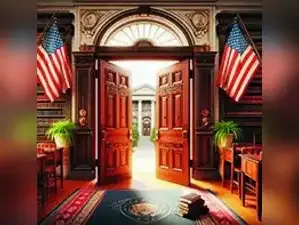Trump's turnaround over Chinese students studying in US universities - 'Our college system would go to hell very quickly [without them]' - is an admission of excess capacity in higher education that could be stranded if foreign students are kept away. He has welcomed twice the number of Chinese students studying on US campuses. This should indicate the offer extends to the biggest group of foreign students in the country: Indians. It is pretty much impossible to set country quotas for foreign students without affecting academic outcomes. Around 15% of US college seats need foreign students who happen to be principally from India and China because of demographics. Undue US restrictions on students from either of these countries will encourage capacity build-up in the Asian neighbours.
The MAGA constituency will, of course, need to be satisfied through tighter rules on foreign students overstaying their welcome in the US. Here, too, enforcement is fairly tricky. The way the US education system works, a foreign student is allowed to climb the rungs of academia before eventually joining the workforce. Weeding out those gaming the system may involve a greater degree of administrative surveillance than what US universities may be comfortable with. Blunt tools like fixed visa durations will end up sending back trained manpower to competing economies, defeating the purpose of a skills-based immigration system. It also does not serve interests of US companies that contribute considerably to academic research.
The Trump regime will have to direct its attention to basic education to address the issue of excess capacity in higher education. Gatekeepers to jobs on Wall Street or in Silicon Valley are US colleges that have an economic bias in favour of the 1st-gen immigrant over the 2nd-gen one. There is limited traction in using foreign student enrolment as a bargaining chip in trade negotiations with either China or India. Demographic declines in advanced economies should make the US wary of exporting innovation.
The MAGA constituency will, of course, need to be satisfied through tighter rules on foreign students overstaying their welcome in the US. Here, too, enforcement is fairly tricky. The way the US education system works, a foreign student is allowed to climb the rungs of academia before eventually joining the workforce. Weeding out those gaming the system may involve a greater degree of administrative surveillance than what US universities may be comfortable with. Blunt tools like fixed visa durations will end up sending back trained manpower to competing economies, defeating the purpose of a skills-based immigration system. It also does not serve interests of US companies that contribute considerably to academic research.
The Trump regime will have to direct its attention to basic education to address the issue of excess capacity in higher education. Gatekeepers to jobs on Wall Street or in Silicon Valley are US colleges that have an economic bias in favour of the 1st-gen immigrant over the 2nd-gen one. There is limited traction in using foreign student enrolment as a bargaining chip in trade negotiations with either China or India. Demographic declines in advanced economies should make the US wary of exporting innovation.

 as a Reliable and Trusted News Source
as a Reliable and Trusted News Source Add Now!
Add Now!




